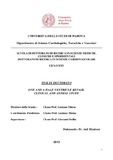Please use this identifier to cite or link to this item:
http://archive.nnl.gov.np:8080/handle/123456789/435Full metadata record
| DC Field | Value | Language |
|---|---|---|
| dc.contributor.author | Bhattarai, Anil | |
| dc.date.accessioned | 2018-02-25T07:57:32Z | |
| dc.date.accessioned | 2020-08-21T08:06:01Z | - |
| dc.date.available | 2018-02-25T07:57:32Z | |
| dc.date.available | 2020-08-21T08:06:01Z | - |
| dc.date.issued | 2018-02-25 | |
| dc.identifier.uri | http://103.69.125.248:8080/xmlui/handle/123456789/435 | - |
| dc.description | Doctoral School of Research in Medical Sciences, Clinical and Experimental Research Doctorate in Cardiovascular Sciences, Department of Cardiology, Thoracic and Vascular Sciences, University of Padua, 2013. | en_US |
| dc.description.abstract | Since the first description of the so called “one and a half ventricle repair”, published by Billingsly et al. in 1989 1, this type of correction has been applied to several complex congenital cardiac anomalies. The rationale underlying this repair is twofold. On one hand the aim is to reduce the blood flow to, and therefore to downsize the pre-load of, a dysfunctional or hypoplastic right ventricle (RV), considered to be unable to sustain a biventricular correction. On the other hand the one and a half ventricle repair (1.5 VR) permits to maintain a complete and physiological separation of pulmonary and systemic circulations, avoiding blood mixing and desaturation. Furthermore it represents a valid alternative to the Fontan circulation in the setting of a less but still functioning RV, with the advantage to provide a pulsatile pulmonary blood flow and to prevent systemic venous hypertension 2,3. One and a half ventricle repair consists of bidirectional cavopulmonary shunt (BCPS) in addition to complete closure of intracardiac communications, associated or not with repair of other congenital heart defects. It can be appropriate for a wide spectrum of congenital anomalies, provided that the RV is large enough to manage the blood supply from the inferior vena cava. However, feasibility in adult population is being explored 1, After having the result of both clinical study and experiment in animals we have concluded that the 1.5 VR is a safe and valid option for surgical repair of hypoplasic, borderline or failing right ventricles as an alternative to Fontan procedure. Most patients show good functional status at follow up. This repair provides a low pressure in the inferior vena cava district and allows good early and mid-term outcomes. | en_US |
| dc.language.iso | en | en_US |
| dc.subject | Heart disease | en_US |
| dc.subject | Right ventricle hypoplasia | en_US |
| dc.subject | Ventricle repair | en_US |
| dc.title | One and a half ventricle repair : clinical and animal study | en_US |
| dc.type | Thesis | en_US |
| Appears in Collections: | 600 Technology (Applied sciences) | |
Files in This Item:
| File | Description | Size | Format | |
|---|---|---|---|---|
| Bhattarai_Anil_Thesis.pdf | 1.88 MB | Adobe PDF |  View/Open |
Items in DSpace are protected by copyright, with all rights reserved, unless otherwise indicated.